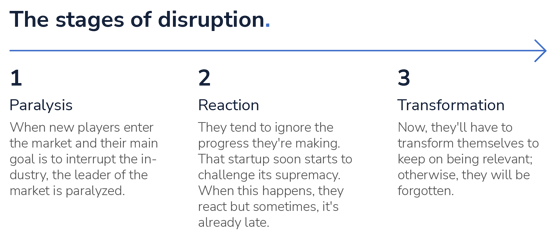According to the dictionary, "disruption" means breakage or interruption; in other words, when we talk about a disruption we are referring to everything that produces a sudden break in the system. Consequently, what was used, disappears. Business disruption is breaking new ground and reshaping our world; now, we are facing the idea of a "disruptive innovation"
What is disruptive innovation?
Disruptive innovation is the innovation that creates a new market or value that alters an existing market, especially in this digital revolution that we are experiencing today. In other words, it is a process where an underrated product or service begins to grow in popularity, displace and eventually replace a market leader. The term was first used in 1995 by Clayton Christensen.
What is even more impressive is the fact that these products start their journey from the bottom and slowly rise to the top and dethrone the market leader. Disruptive innovators have smaller margins, niche markets, and simple product offerings.
Clayton Christensen, who coined the word "Disruptive Innovation," highlighted the reason why most companies struggle with disruption when he said:
"The reason why it's so difficult for existing companies to capitalize on disruptive innovations is that their processes and business model make them believe they're good at the existing business and make them bad at competing."
<<< Continuous improvement: Have your processes improved in the last 5 years? >>>
The stages of disruption
Disruptive innovations affect markets by offering products or services that are generally:
- Cheaper
- Faster
- Of best quality
- More efficient
- More long-lasting

If your company's goal is to grow profitably, you need to understand how to start disrupting the markets you serve and, in the process, take away market share from competitors.
<<< Change of technology in the company: 6 tips to keep in mind >>>
Five steps to disruptive innovation
- Take a close look at the markets your business serves, the products being sold, and active competitors.
- Understand the "trajectory" of product performance growth over time in each market your company serves.
- Investigate the purchasing behavior of customers in each market: determine what changes are evident in the performance of the products demanded by customers.
- Find opportunities for disruption when product performance offered by sellers exceeds performance demanded by customers; in other words, the trajectories are different.
- Now your company can work to develop products or services that meet the performance demanded by customers at a lower price and offer better-perceived value. These products will baffle competitors who have outbid you.
Challenges with disruptive innovation
Of course, there are challenges for companies that want to deliver disruptive products, and it's important to be aware of these challenges early on.
- Disruption and commodification go hand in hand. Companies that go overboard with their products simply won't win in the marketplace because disruption will steal markets or commoditization will steal profits. You must be prepared to understand that where the money is will change in the markets as these markets are affected.
- Disruptive innovation requires a separate strategic point of view: you must continually assess emerging and unforeseen problems, successes, and opportunities.
- Understanding what customers need and will buy is difficult and requires understanding customer buying behavior.
- It is difficult to quickly achieve profitability with disruptive innovations, these products take time to emerge and become visible to customers.
<<< Digital revolution: how it is affecting your company >>>
How is disruption transforming the business landscape?
Here are four ways disruption is changing the business world and creating new opportunities.
1. Convenience delivery
With customers demanding convenience, businesses are looking for new ways to serve their customers in the most, redundantly, convenient way. One of the main reasons behind the growing popularity of eCommerce is convenience. You don't have to visit a physical store to buy your favorite products. You can buy the product online from the comfort of your room and have it delivered to your door. Convenient!
The main e-commerce stores such as Mercado Libre, for example, offer millions of products at your fingertips and further improve the shopping experience by offering complementary services such as the sum of points for the purchase, which comes with additional benefits such as free shipping and additional discounts.
2. Redefining business models
Most people subscribe to cable TV, newspapers, and magazines, but business disruptors are looking to change that. Companies like Dollar Shave Club and Birchbox are at the forefront in this regard in addressing everyday subscription needs by disrupting traditional business models.
Dollar Shave Club experimented with providing affordable razors to customers and it worked. Birchbox shook up the fashion industry by delivering monthly boxes of makeup, skincare, and hair products to women's doorsteps. Thanks to high-speed Internet connections and powerful mobile devices, companies can implement subscription-based services more efficiently. Netflix and Spotify are some of the best examples in this regard.
3. Effective communication and collaboration
Business disruptors are harnessing technology to change the way we used to communicate and collaborate. Communication tools like Zoom allow you to stay connected with your remote teams. Cloud storage options like Dropbox and Google Drive let you create, edit, collaborate and share documents with your team members. Some task management software like Monday.com helps you improve productivity.
4. Revolutionizing the logistics and transport industry.
Logistics and transportation are some of the hottest industries that are ripe for disruption. Autonomous vehicles, self-driving trucks, and drones are no longer a dream, but a reality. E-commerce businesses can take advantage of these logistics innovations and ensure on-time delivery. Going back to the first example, Mercado Libre created Mercado Envíos and has changed the way we order a product from point A to point B. As companies move toward automation, it will help them minimize human error and ensure the seamless movement of goods from one place to another. In addition, it reduces costs by avoiding delays.

%20(1).jpg?width=300&name=wp9131686%20(1)%20(1).jpg)




¿Nos dejas un comentario?